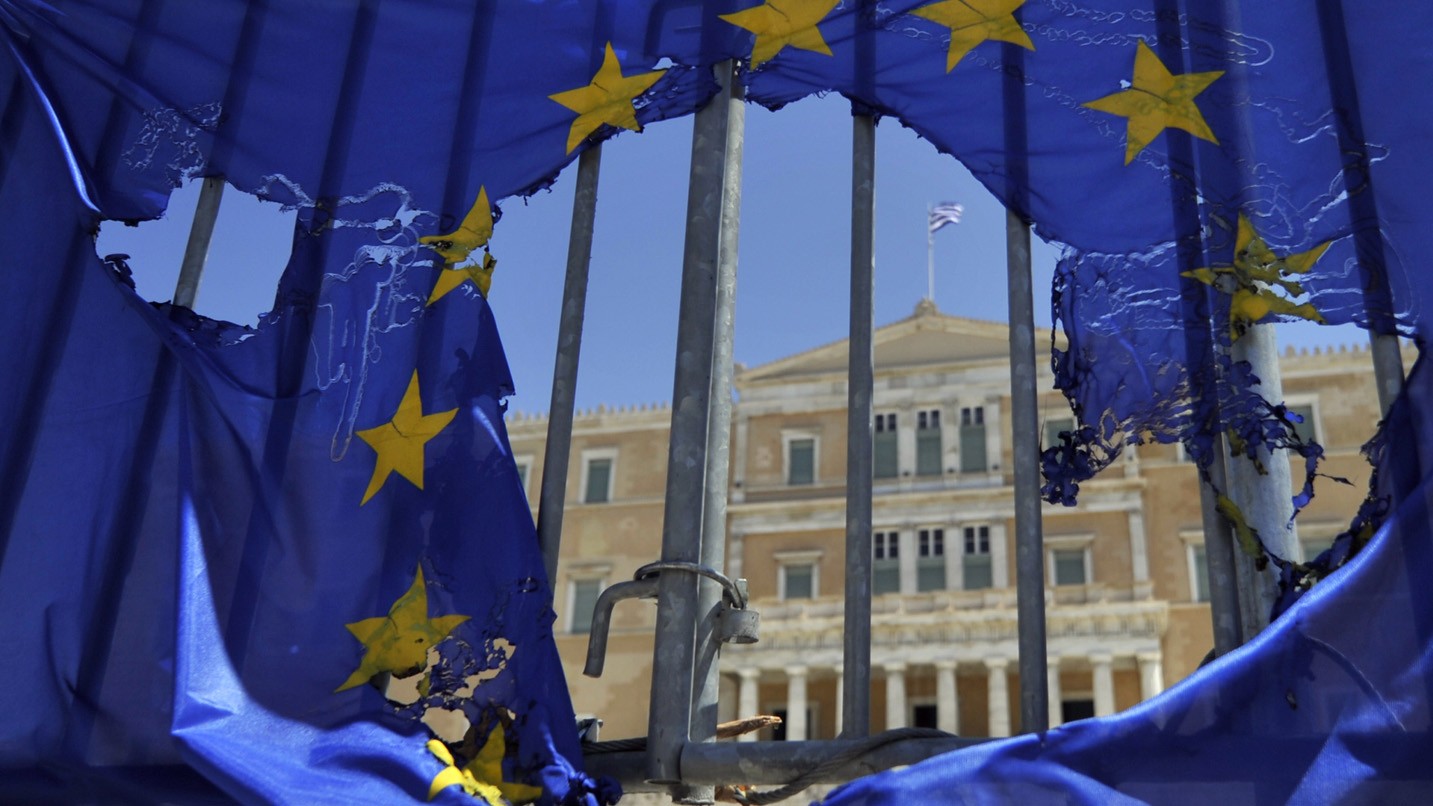By the Truth Committee on Greek Public Debt
The institutions that created the Troika are the main creditors to Greece, and as a group they apply tremendous pressure to secure their repayment. This chapter lays out the basic set of relevant issues that the Committee wants to highlight looking at the main current creditors – the EU member states, the EFSF, the IMF, the ECB and private creditors. We present the contentious nature of these debts, delineating their key characteristics, which are further analysed in Chapter 8. The majority of the loans received from the bailouts were used to repay existing debts. Approximately 10% of the bailout programme was used to finance the budget, as shown in Table 3.1.
TABLE 3.1
Use of official funding, 2010 to 2015

TABLE 3.2
Public debt of Greece by component, as of 30/04/15

1. Bilateral Loans
• The pooled bilateral loans were set up in May 9 of 2010 and disbursed over six quarterly tranches. Total disbursements amounted to €52.9 billion.
TABLE 3.3
Composition of Bilateral Loans to Greece (millions euros)

• The bilateral loans are put into effect through the combination of the Intercreditor Agreement and the Loan Facility Agreement, as described in Chapter 4. It was declared that initiating these loans with a high interest rate would act as an “incentive to return to market-based financing as soon as feasible”.
• As a result of this policy choice €2,614 billion of interest payments were made to the member states by March 2012. Set at the variable rate of 3-month Euribor plus 300 basis points extra charge for the first three years, the original rates were onerous. With the Euribor rate peaking at 1.609% in August 2011 the interest on the bilateral loans reached over 4.6%. As some of the creditor countries’ borrowing costs were lower than the lending rate, some lenders profited out of the loans. The gradual easing of the loans’ terms, currently at Euribor + 50 basis points is an implicit admission that the original terms were usurious.
• The loans were portrayed as if used to assist Greece in paying wages and pensions. Indicative of this portrayal is Eurogroup president Juncker’s statement that disbursements are used to recapitalise banks, pay wages, pensions and government suppliers. This is however misleading. The bilateral loans were used primarily for debt repayment: between May 2010 and September 2011 86% of the loans were used solely for debt repayment. The remainder was not even used in its entirety for budget support, but rather to pay for the setting up of the Hellenic Financial Stability Fund.
2. EFSF
• The EFSF, based in Luxembourg, was created in 2010 to preserve financial stability in Europe. Nonetheless, by creating additional debts for individual member states, the scheme deteriorated the economic situation for Europe as a whole and especially for Greece.
• EFSF loans are financed through the issuance of funding instruments, which are backed by guarantees of euro-area member states. Guarantees were increased from €440.00 billion in 2010 to €779.78 billion in 2011. By 2013, Portugal, Greece, Ireland and Cyprus had stepped out from the EFSF changing the guarantees of the EFSF to €724.47 billion, which remains the current commitment. As the number of highly rated guarantors of the fund dwindles, as occurred after France’s downgrade, so too does the stability of the EFSF. Eventually the scheme was replaced by the ESM.
• The EFSF disbursed €141.8 billion of which €10.9 was returned on the 27th February 2015, leaving €130.9 billion debt to Greece. BG [Accessed 15. June 12, 2015].]] From the total disbursed amount, €108.2 billion (76.3%) was disbursed in 2012, €25.3 billion (17.8%) in 2013, and €8.3 billion (5.9%) in 2014. The repayment of these loans will stretch to 2054.
• The interest ratesof EFSF loans are calculated on the following basis: Greece pays the EFSF financing cost plus 10 basis points guarantee fee. For each loan disbursement, there is an additional loan disbursement fee of 50 basis points. The country finances EFSF activities, bearing all of its costs, even if for whatever reason the disbursement of the Pre-Funding Operations does not take place. This scheme has imposed significant costs for Greece, and the amount paid as ‘service fee’ between 2012 and 2014 totaled €740 million. PSI-related debts, for a time, incurred interest, but since 2014 all EFSF interest payments are deferred until 2023.
• Only a small share of the loans contributed to the government’s regular expenditure. The bailout was disbursed mainly in EFSF securities: notes worth €34.6 billion subsidized the PSI, €11.3 billion notes were used in the ‘Debt buy back’ and €37.3 billion has been cur-rently borrowed for the Greek banks.
• The majority of the EFSF bailout was disbursed ‘in kind’, not in euros. Cashless operations constitute 65.4% of total EFSF loans. As elaborated in Chapter 4, the EFSF facilitates an exchange of obligations, mean-ing that the loans are, on the whole, not designed to enter Greece, but rather be used directly, inter alia, for the repayment of debts.
3. IMF
• The European Parliament and the IMF acknowledge that the IMF programme results were “uneven” and contained “notable failures”. This is a gross underestimation of the extent of the deceit towards the Greek people.
• Concrete negotiations surrounding the size and type of the loan between the IMF and Greece had be-gun from March 2010. First Deputy Managing Director, Lipsky, assured the Greek representative to the IMF that the Greek loan size would be decided by the Board on a political basis, rather than calculated according to the quota allowance. The Stand-By Arrangement (SBA) loan was concluded at a record breaking amount of 3,212% of Greece’s quota.
• The IMF knew from the outset that there was no historical precedent for such a scale of fiscal adjustment, stating in March 2010 that the programme would result in “sharp contraction of demand, and an attendant deep recession, severely stretching the social fabric”. As such, several members of the Board pointed to the programme’s “immense” risks.
• Waivers of applicability for performance criteria were accepted by the IMF Board in seven out of the ten programme reviews highlighting that ubiquitous observance of conditionality was not essential for continued provision of financing, whilst also indicating intrusive and unreasonable conditions. The IMF insists on reforms despite “considerable social unrest” and “popular dissatisfaction with reforms”.
The systematic bias and lack of transparency in the IMF’s methodology for forecasting is evidenced by the IMF’s Internal Evaluation Office, particularly in high profile cases and lending under exceptional access. The original Debt Sustainability Analysis was positively skewed to the upside, utilising grossly unrealistic assumptions discussed in Chapter 5 and 6. IMF staff could not sign off that Greek debt was sustainable in the medium term to a high probability and as such did not qualify for exceptional access under the second criterion on debt sustainability so the Board neces-sitated an amendment to its policy during the same Board meeting that approved Greece’s SBA, a fact resented by several Eds.
Despite overt admission that mid-term debt sustainability is lacking, programme approval rested on excessively onerous repayment burdens. Over the past five years (May 2010 to 2015) over €3 billion has been paid in interest and charges. The interest rate for the second programme is the basic rate of charge (currently SDR interest rate plus 100 basis points), plus a surcharge of 200 basis points on credit outstanding above 300% of the quota. This rises to 300 basis points when the amount outstanding three years after the programme began is over 300% of quota, and includes a 50 basis points service charge for each amount drawn. As of end 2014 €23.9 billion is recorded as an out-standing debt to the IMF; this is recorded as a promissory note issued by the Greek government, and kept at the Bank of Greece which acts as a fiscal agent for the Hellenic Republic vis-a-vis the IMF.
TABLE 3.4
Summary of IMF Disbursements
and Payments (Billions of Euros), end 2014

Source : IMF, Financial Statistics, Using the Programme Exchange Rate as defined in each technical MOU.
4. ECB
• The ECB bought Greek bonds in the secondary market
In May 2010 the ECB established the Securities Markets Programme (SMP). Under the terms of this Decision, from May 2010 to September 2012, the ECB bought over €210 billion of public bonds issued by Italy, Spain, Ireland, Portugal and Greece on the secondary market.The outstanding amount is €138,1 billion in 29 May 2015, with €27 billion owed by Greece.
• The ECB is Greece’s biggest creditor in the short and medium term
After the EFSF and the IMF, the ECB is Greece’s third largest creditor, with Greece owing €27 billion in April 2015. However, no other creditor has so many claims on Greece until the end of the decade, not even the IMF. Greece has to pay €6.7 billion to the ECB and other central banks of the European System of Central Banks in 2015 and €23 billion over the next five years.
• The ECB bought Greek debt on the secondary market in order to serve the interests of European private banks
The ECB has used this mechanism at its discretion for undemocratic purposes interfering in the political sovereignty of european member states and acting against their Constitutions between May 2010 and July 2012, when it was substituted by the Outright Monetary Policy Program. This decision served the interests of the private financial sector, allowing the French and German banks to reduce exposure on their holdings of Greek bonds. The IMF is very clear about that: “A delayed debt restructuring also provided a window for private creditors to reduce exposures and shift debt into official hands”. Moreover, the purchase by the ECB of significant quantities of bonds on the secondary market increased the price of these financial instruments. This allowed the bond-holders to reduce their losses the moment they sold them. We should also note that between May 2010 and September 2012, the ECB decided to freeze the SMP several times, which created market stress and had an influence on different political decisions, such as the increase in the EFSF lending capacity to €440 billion.
Such political influence clearly falls beyond the mandate given to the ECB and it represents a questionable breach of its function.
• The ECB bought Greek debt with conditionalities
Contrary to the statutes necessitating the ECB to act independently, the ECB’s interventions in the secondary market was predicated on political decisions regarding beneficiary member states, particularly with regard to the reduction of their public deficit. The ECB decision of 14 May 2010 creating the SMP states: “The Governing Council will decide on the scope of the interventions. The Governing Council has taken note of the statement of the euro area Member State governments that they ‘will take all measures needed to meet their fiscal targets this year and the years ahead in line with excessive deficit procedures’ and the precise additional commitments taken by some euro area Member State governments to accelerate fiscal consolidation and ensure the sustainability of their public finances. (…) As part of the Eurosystem’s single monetary policy, the outright purchase of eligible marketable debt in-struments by Eurosystem central banks under the programme should be implemented in accordance with the terms of this Decision”.
On 31st May 2010, Jean-Claude Trichet, President of the ECB, stated the ECB’s response to the recent tensions in financial markets: “It is crucial that governments implement rigorously the measures needed to ensure fiscal sustainability. It is in the context of these commitments only that we have embarked on an intervention programme in the securities markets. (…) The Securities Market Programme is an extraordinary action, which was undertaken in the situation of severe tensions in financial markets. I would like to stress that the rigorous application of the adjustment programmes by governments is essential to guarantee the progressive return to a more normal functioning of financial markets”.
• The ECB profits from Greek debt
The ECB purchased Greek bonds under the SMP cheaper than their nominal value on the secondary market but asked for full reimbursement (nominal value and interest payment). One estimation cites that the ECB spent €40 billion to acquire the estimated face value of €55 billion, which if held to maturity, the ECB would reap the full difference between the price paid and the repayment plus interest. The ECB has already received hefty interest from Greece, as the rates on the Greek bonds it holds are high.
Although the ECB holds far less Greek debt than it does from Italy or Spain, Greece pays much more in-terest to the ECB. Over the course of 2014, the Greek Government paid €298 in interest on ECB loans, which represents 40% percent of the €728 million income that the ECB received from the total interest paid by the five countries in the SMP program. This is despite the fact that the Greek debt with the ECB represents only 12% of the total.
TABLE 3.5
Debt due to the ECB by countries under the SMP (February 2015)

After the public revelation that the ECB and the Na-tional Central Banks (NCBs) made profits on the SMP program, the Euro-area governments agreed in November 2012 to transfer an amount equal to any profit on SMP holdings of the country’s debt as long as it complies with the conditions of its surveillance program. The ECB owes Greece almost €2 billion from the profits the ECB has made. Mario Draghi said “the income generated by Greek government bonds acquired by the ECB under the SMP is part of the ECB’s net profit. The ECB’s net profit is distributed to all NCBs of the euro area according to their shares in the ECB capital key, including the NCBs of the countries that are subject to an EU-IMF financial assistance programme (…) not only the ECB but also all the euro area NCBs have purchased bonds under the SMP in the past, which means that income on Greek government bonds has been accrued by both the ECB and the NCBs. Furthermore, I would like to stress that (i) the euro area NCBs cannot distribute specific (“earmarked”) income to their shareholders before having calculated the overall profit (or loss) in a financial year; and (ii) they can only distribute their profits to their shareholders (including the respective governments), and not directly to a Member State that is not a shareholder”.
• The ECB did not participate in the debt restructuring of 2012
In February 2012 the restructuring of Greek debt involved a reduction of 53.5% of Greek sovereign securities held by private creditors. However the ECB refused to participate in the debt restructuring, whether through canceling part of the debt stock, postponing its maturity or reducing the interest rates. This was justified under the premise of “independence from any government”.
5. Private creditors
“The protection of bondholders was seen as an EU necessity in the interests of financial stability”; The Budgets Committee in the European Parliament acknowledges “we have in fact transferred the wild card from private banks to governments.”
• Domestic financial sector
Despite the widely held affirmations that the Greek financial sector was solvent, the problems in the Greek financial sector were significant. Mission chief Poul Thomsen underscored that “financial sector stress” in the Greek economy is a key problem that determined market access loss for the sovereign.
TABLE 3.6
State Aid to the Financial Sector, billion euro

Source : DG Competitions
• Foreign banks
The strictly confidential document detailing the IMF Board meeting of Greece’s SBA mentions that “Dutch, French and German chairs conveyed to the Board the commitments of their commercial banks to support Greece and broadly maintain their exposures”. Instead, the foreign banks disrespected their commitment, and as detailed in Chapter 4 of this report, the bailout mechanisms facilitated the transfer of debt ownership from private banks to the official sector. The European Parliament reaffirms that the bailouts shielded the “banking sector from losses by transferring large amounts of programme country sovereign debt from the balance-sheet of the private sector to that of the public sector”.
• PSI Holdouts
Out of the eligible €205.5 billion, the final participation was €199.2 billion. The Troika’s bailout loans, far from being utilized to help pay for wages and pensions are instead used to reward the holdouts, many of which are known vulture funds, by repaying them in full. From May 15, 2012 until the end 2015, €3.615 billion has been repaid at an average of 4.3% interest.
For more reports by the Truth Committee on the Greek Public Debt, CLICK HERE
Ask me anything
Explore related questions





